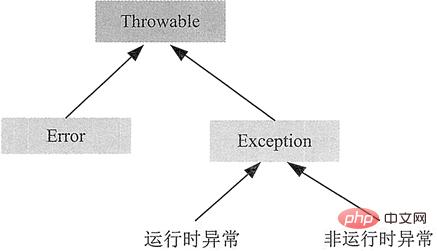What is exception in java?

Exception refers to an error that occurs during the running of the program. It occurs during the running of the program.
Exception in Java, also known as exception, is an event that occurs during program execution, which interrupts the normal instruction flow of the executing program. In order to handle running errors in the program promptly and effectively, exception classes must be used. [Recommended learning: java course]
Causes and usage principles of exceptions
In Java, there are three main reasons for an exception to occur: One reason:
Java internal error exception occurred, an exception generated by the Java virtual machine.
Exceptions caused by errors in the program code written, such as null pointer exceptions, array out-of-bounds exceptions, etc. This kind of exception is called an unchecked exception, and it is generally necessary to handle these exceptions centrally in certain classes.
Exceptions generated manually through the throw statement are called checked exceptions and are generally used to inform the caller of the method some necessary information.
Java handles exceptions through an object-oriented approach. During the running of a method, if an exception occurs, the method will generate an object representing the exception and hand it to the runtime system. The runtime system will look for the corresponding code to handle the exception.
We call the process of generating an exception object and submitting it to the runtime system as throwing an exception. The runtime system searches the method's call stack until it finds an object that can handle that type of exception. This process is called catching the exception.
Java exceptions force users to consider the robustness and security of their programs. Exception handling should not be used to control the normal flow of the program. Its main function is to capture exceptions that occur when the program is running and handle them accordingly. When writing code to handle exceptions that may occur in a certain method, you can follow the following three principles:
Use try catch statements in the current method declaration to catch exceptions.
When a method is overridden, the method that overrides it must throw the same exception or a subclass of the exception.
If the parent class throws multiple exceptions, the overriding method must throw a subset of those exceptions and cannot throw new exceptions.
Exception type
All exception types in Java are subclasses of the built-in class java.lang.Throwable class, that is, Throwable is located in the exception The top level of the class hierarchy. There are two exception branches, Exception and Error, under the Throwable class, as shown in Figure 1.

Figure 1 Exception structure diagram
The Throwable class is the super class of all exceptions and errors. There are two subclasses below: Error and Exception, which represent errors and exceptions respectively. Among them, the exception class Exception is divided into runtime exception and non-runtime exception. There is a big difference between these two exceptions, also called unchecked exception (Unchecked Exception) and checked exception (Checked Exception).
The Exception class is used for exceptions that may occur in user programs. It is also a class used to create custom exception type classes.
Error defines exceptions that are not expected to be caught by the program under normal circumstances. Exceptions of type Error are used by the Java runtime to display errors related to the runtime system itself. Stack overflow is an example of this error.
This chapter does not discuss exception handling of the Error type, because they are usually catastrophic and fatal errors that are beyond the control of the program. The remainder of this chapter discusses exception handling of the Exception type.
Runtime exceptions are exceptions of the RuntimeException class and its subclasses, such as NullPointerException, IndexOutOfBoundsException, etc. These exceptions are unchecked and can be captured or not processed in the program. These exceptions are generally caused by program logic errors, and the program should try to avoid the occurrence of such exceptions from a logical perspective.
Non-runtime exceptions refer to exceptions other than RuntimeException, and they all belong to the Exception class and its subclasses. From the perspective of program syntax, it is an exception that must be handled. If it is not handled, the program will not be compiled. Such as IOException, ClassNotFoundException, etc. and user-defined Exception exceptions. Generally, no custom checked exceptions are used. Table 1 lists some common exception types and their functions.

The above is the detailed content of What is exception in java?. For more information, please follow other related articles on the PHP Chinese website!

Hot AI Tools

Undresser.AI Undress
AI-powered app for creating realistic nude photos

AI Clothes Remover
Online AI tool for removing clothes from photos.

Undress AI Tool
Undress images for free

Clothoff.io
AI clothes remover

Video Face Swap
Swap faces in any video effortlessly with our completely free AI face swap tool!

Hot Article

Hot Tools

Notepad++7.3.1
Easy-to-use and free code editor

SublimeText3 Chinese version
Chinese version, very easy to use

Zend Studio 13.0.1
Powerful PHP integrated development environment

Dreamweaver CS6
Visual web development tools

SublimeText3 Mac version
God-level code editing software (SublimeText3)

Hot Topics
 1669
1669
 14
14
 1428
1428
 52
52
 1329
1329
 25
25
 1273
1273
 29
29
 1256
1256
 24
24
 PHP: A Key Language for Web Development
Apr 13, 2025 am 12:08 AM
PHP: A Key Language for Web Development
Apr 13, 2025 am 12:08 AM
PHP is a scripting language widely used on the server side, especially suitable for web development. 1.PHP can embed HTML, process HTTP requests and responses, and supports a variety of databases. 2.PHP is used to generate dynamic web content, process form data, access databases, etc., with strong community support and open source resources. 3. PHP is an interpreted language, and the execution process includes lexical analysis, grammatical analysis, compilation and execution. 4.PHP can be combined with MySQL for advanced applications such as user registration systems. 5. When debugging PHP, you can use functions such as error_reporting() and var_dump(). 6. Optimize PHP code to use caching mechanisms, optimize database queries and use built-in functions. 7
 PHP vs. Python: Understanding the Differences
Apr 11, 2025 am 12:15 AM
PHP vs. Python: Understanding the Differences
Apr 11, 2025 am 12:15 AM
PHP and Python each have their own advantages, and the choice should be based on project requirements. 1.PHP is suitable for web development, with simple syntax and high execution efficiency. 2. Python is suitable for data science and machine learning, with concise syntax and rich libraries.
 Break or return from Java 8 stream forEach?
Feb 07, 2025 pm 12:09 PM
Break or return from Java 8 stream forEach?
Feb 07, 2025 pm 12:09 PM
Java 8 introduces the Stream API, providing a powerful and expressive way to process data collections. However, a common question when using Stream is: How to break or return from a forEach operation? Traditional loops allow for early interruption or return, but Stream's forEach method does not directly support this method. This article will explain the reasons and explore alternative methods for implementing premature termination in Stream processing systems. Further reading: Java Stream API improvements Understand Stream forEach The forEach method is a terminal operation that performs one operation on each element in the Stream. Its design intention is
 PHP vs. Other Languages: A Comparison
Apr 13, 2025 am 12:19 AM
PHP vs. Other Languages: A Comparison
Apr 13, 2025 am 12:19 AM
PHP is suitable for web development, especially in rapid development and processing dynamic content, but is not good at data science and enterprise-level applications. Compared with Python, PHP has more advantages in web development, but is not as good as Python in the field of data science; compared with Java, PHP performs worse in enterprise-level applications, but is more flexible in web development; compared with JavaScript, PHP is more concise in back-end development, but is not as good as JavaScript in front-end development.
 PHP vs. Python: Core Features and Functionality
Apr 13, 2025 am 12:16 AM
PHP vs. Python: Core Features and Functionality
Apr 13, 2025 am 12:16 AM
PHP and Python each have their own advantages and are suitable for different scenarios. 1.PHP is suitable for web development and provides built-in web servers and rich function libraries. 2. Python is suitable for data science and machine learning, with concise syntax and a powerful standard library. When choosing, it should be decided based on project requirements.
 PHP's Impact: Web Development and Beyond
Apr 18, 2025 am 12:10 AM
PHP's Impact: Web Development and Beyond
Apr 18, 2025 am 12:10 AM
PHPhassignificantlyimpactedwebdevelopmentandextendsbeyondit.1)ItpowersmajorplatformslikeWordPressandexcelsindatabaseinteractions.2)PHP'sadaptabilityallowsittoscaleforlargeapplicationsusingframeworkslikeLaravel.3)Beyondweb,PHPisusedincommand-linescrip
 PHP: The Foundation of Many Websites
Apr 13, 2025 am 12:07 AM
PHP: The Foundation of Many Websites
Apr 13, 2025 am 12:07 AM
The reasons why PHP is the preferred technology stack for many websites include its ease of use, strong community support, and widespread use. 1) Easy to learn and use, suitable for beginners. 2) Have a huge developer community and rich resources. 3) Widely used in WordPress, Drupal and other platforms. 4) Integrate tightly with web servers to simplify development deployment.
 PHP vs. Python: Use Cases and Applications
Apr 17, 2025 am 12:23 AM
PHP vs. Python: Use Cases and Applications
Apr 17, 2025 am 12:23 AM
PHP is suitable for web development and content management systems, and Python is suitable for data science, machine learning and automation scripts. 1.PHP performs well in building fast and scalable websites and applications and is commonly used in CMS such as WordPress. 2. Python has performed outstandingly in the fields of data science and machine learning, with rich libraries such as NumPy and TensorFlow.




